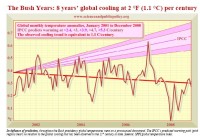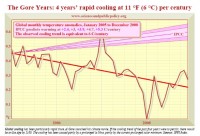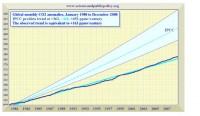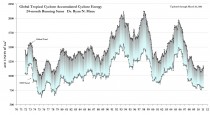By David Ameling
I had a career in computer software and therefore know that computer models have to be proven. They should never be used to prove anything. They can only be used to give a best guess prediction that reflects the beliefs of those who designed the model. This made me doubt carbon dioxide was causing global warming, because the only proof given was from computer models. This is not scientific proof. I have a bachelor’s degree in physics that did not specialize in any particular field of physics. Instead it gave me a broad knowledge of physics, which includes thermodynamics. With this little bit of knowledge I did research to answer the questions I had about climate change. I had 13 questions which I researched. The results of my research did not solve the question as to what to expect for climate change, but it did give me a better understanding of the causes of climate change. I would like to share the results of my research with you and the readers of your website.
I hope this will give a better understanding (on an undergraduate level) of the causes of climate change and stimulate others to research the subject.
1. Burning fossil fuels creates carbon dioxide. Where did the carbon in fossil fuels come from ?
All the carbon in fossil fuels came from the atmosphere via photosynthesis. Photosynthesis took carbon dioxide from the atmosphere, energy from sunlight, and water to make biomass. Overtime the biomass was converted into fossil fuels. Burning fossil fuels recycles carbon back into the atmosphere from where it came.
2. What are the primary Greenhouse Gases
Water vapor and carbon dioxide are the main greenhouse gases. Water vapor varies from 0 to 4 percent of the atmosphere. Water vapor is about 1 percent of the atmosphere. Carbon dioxide is about .04 percent of the atmosphere. Water vapor makes up 95 percent of the greenhouse gases. The warmest temperatures on earth are recorded in the driest deserts where 95 percent of the greenhouse gases are absent. Why does this happen?
Temperatures rise rapidly where there is an absence of water vapor because a lot of heat energy (latent heat) is required to change ice into water and to change water into water vapor.
Water vapor allows clouds to form, increasing the earth’s albedo (the percentage of radiation reflected into space). Warming is hindered until the water droplets in the clouds are changed into water vapor. After the clouds are changed into water vapor temperatures begin to rise more rapidly. Temperature is is a poor indicator of how much heat energy is in the atmosphere. Humidity and heat capacity must be considered. The latent heat required to to change water droplets into water vapor is still in the atmosphere, but this latent heat did not change the temperature.
3. What causes an ICE AGE?
There are many possible causes of ice ages, but the lack of carbon dioxide is not one of them. Even those who believe carbon dioxide can cause great warming don’t believe the lack of carbon dioxide causes great cooling.
Just as you don’t need a degree in astrophysics to know the sun will rise tomorrow, you don’t need advanced degrees in climatology to know there will be another ice age. The simple proof is “They have always occurred and they will continue to occur”. Carbon dioxide has no influence in the matter. Those who want to know more about the most likely cause of ice ages should read about Milankovitch cycles.
David J. Ameling
Read more here and comment back to David via Icecap email.
By Anthony Watts, Watts Up With That
Here’s something you don’t see everyday: a university sending out a press release showing the potential benefits on crop yields of elevated atmospheric CO2 levels. - Anthony
High CO2 boosts plant respiration, potentially affecting climate and crops
The leaves of soybeans grown at the elevated carbon dioxide (CO2) levels predicted for the year 2050 respire more than those grown under current atmospheric conditions, researchers report, a finding that will help fine-tune climate models and could point to increased crop yields as CO2 levels rise. The study, from researchers at the University of Illinois and the U.S. Dept. of Agriculture, appears this week in the Proceedings of the National Academy of Sciences. Plants draw CO2 from the atmosphere and make sugars through the process of photosynthesis. But they also release some CO2 during respiration as they use the sugars to generate energy for self-maintenance and growth. How elevated CO2 affects plant respiration will therefore influence future food supplies and the extent to which plants can capture CO2 from the air and store it as carbon in their tissues. While there is broad agreement that higher atmospheric CO2 levels stimulate photosynthesis in C3 plants, such as soybean, no such consensus exists on how rising CO2 levels will affect plant respiration.

Andrew Leakey and assistants at work in the Soy FACE facility at Illinois. Click here for more information.
“There’s been a great deal of controversy about how plant respiration responds to elevated CO2,” said U. of I. plant biology professor Andrew Leakey, who led the study. “Some summary studies suggest it will go down by 18 percent, some suggest it won’t change, and some suggest it will increase as much as 11 percent.” Understanding how the respiratory pathway responds when plants are grown at elevated CO2 is key to reducing this uncertainty, Leakey said. Read more here.
A statement by Viv Forbes, Chairman of the Carbon Sense Coalition
The Carbon Sense Coalition today accused coal companies, power companies and governments of gross negligence for wasting resources from shareholders, electricity consumers and taxpayers on quixotic dreams to capture and bury carbon dioxide from power stations. The Chairman of the Carbon Sense Coalition, Mr Viv Forbes, said that there were five main objections to Carbon Capture and Storage (CCS):
Firstly, there are no possible climate benefits because carbon dioxide in the atmosphere does not control climate and the tiny effect of man’s emissions is wholly beneficial. There has been no open scientific enquiry into the justification for demonising carbon dioxide, and a large and growing scientific opposition to the whole global warming hysteria.
Secondly, there is no public health justification for CCS because carbon dioxide is not a pollutant. It is a colourless, non-toxic gas and in fact a valuable plant food. A warm climate with abundant carbon dioxide in the atmosphere will be beneficial for all life.
Thirdly, CCS can never be “economic” because there are huge costs and zero benefits.
Fourthly, CCS will divert a vast amount of community savings into stupid investments which will be abandoned in a more enlightened future time.
And finally, neither taxpayers nor shareholders have seen a full cost benefit analysis of the CCS proposals by independent experts. They have no idea of the guaranteed huge cost and the illusory benefits.
“Every day we hear people sounding off about “dirty coal”. Coal is a natural substance and every element in coal reflects the composition of living plants and plays a part in sustaining healthy life. Coal is as natural as the forests from which it came, with the same fuel components as natural gas, more natural than distilled ethanol, and as clean the healthiest soil in a good garden. Like any substance you can name, coal can be dangerous if misused - people in a sealed room can suffocate from the open fire burning wood, or from their own breathing, but sensible people make sure a window is open to allow their combustion products to diffuse into the vast atmosphere.
The same problem arises if there are too many open fires in cities, where poor combustion and lack of modern pollution scrubbers produces a toxic concentration of soot, ash and polluting gases (as in Asia now). Poor combustion with insufficient oxygen can also produce the poisonous gas carbon monoxide, but nowhere is carbon dioxide a problem in the open atmosphere.
“Clean electricity from modern coal-fired power stations is what has cleaned up the smogs of London and Pittsburgh, and can do the same for the Asian smog. Once diffused into the atmosphere, carbon dioxide (and all other products from burning coal) become plant food and mineral nutrients for the whole plant kingdom. Plants extract carbon dioxide from the air, consume the carbon and return the oxygen to the atmosphere. It is the key link in the cycle of life. The earth is already burying valuable carbon resources in vast deposits of limestone, dolomite, magnesite and gypsum in oceans and lakes and in organic matter being buried at sea by flooding rivers.
“Despite all the hysteria by Al Gore and others, the carbon dioxide levels in the atmosphere are lower now than at many times in earth’s history. So low in fact that if we were successful in capturing and burying all of man’s emissions of carbon dioxide, many people may starve as plant growth would be so reduced that food production would not support today’s population. Burning fossil fuels has had the serendipitous effect of aiding the world production of food and supporting our large populations.
“We hear proponents bleating wistfully about the possibilities of proving that CCS is “economic”. It can NEVER be economic, because there are no benefits - nothing to offset the huge capital costs, nothing to repay the large increase in power generating costs. It can only ever be a mammoth waste of energy, resources and money. “Building large high pressure pipelines that end up in carbon cemeteries can only be made to look economic by heavy taxes on emissions of harmless carbon dioxide. But even with this artificial subsidy, so-called clean coal plants are being abandoned because of the escalating costs.
“The engineering obstacles to carbon capture and storage guarantee that the capital and operating costs will be very large. For every tonne of coal burnt, and after all the polluting gases and soot are removed, over 3 tonnes of carbon dioxide remains. This huge quantity of hot gas has to be captured, cooled, separated from the other “greenhouse gas” (water vapour), compressed and pumped in huge high-pressure pipelines to some distant spot where deep wells have been drilled to allow this valuable gas to be pumped underground, where it is hoped it will stay.
If CCS is installed, electricity costs must rise dramatically. Even the research, planning and design costs will be huge, decades before any CCS plant will operate. Queensland alone has already committed over one billion dollars to this foolish dream. (In a few favourable locations this gas could be used to drive more oil or gas out of depleted oil fields and this proven technique is already being used where it makes economic sense - it should not be force fed by carbon taxes.) “All of this separation, compressing and pumping requires more energy from more coal burning. So we burn more coal, each tonne of which produces over three tonnes of CO2, in order to reduce emissions of CO2?? Who is fooling whom? The main game is to reduce consumption of our valuable fossil fuels, so why would anyone support this wanton destruction of resources, energy and capital? And why stop at power stations? There are also hundreds of cement plants, natural gas projects, steel works, coke plants and smelters of all kinds that release carbon dioxide. Are they all destined to be strangled by CCS?
“Even if some naive countries, corporations or governments do spend community savings on these white elephants, they will soon be abandoned. They will be as useful to us as the pyramids were to the Pharaohs, and future generations will marvel at the abandoned compressors, the derelict pump stations and the pipelines going nowhere. “Green extremists know that CCS is a fantasy but see it as a great weapon to cripple coal and make their fairyland windmills and solar panels look sensible. Their green plans aim to put anyone who relies on coal deep into the red.” See release here.
By Portland Press Herald’s MD Harmon
If you, I and everybody else who pays for electricity, gas or any other kind of energy are about to see our bills go through the stratosphere to pay for someone else’s faith-based initiative, we shouldn’t take it quietly. So I won’t. Billions are going to be vacuumed out of consumers’ wallets by “cap-and-trade” measures like the Regional Greenhouse Gas Initiative (RGGI) that Maine and other Northeastern states have implemented, and by a bill in Congress that would impose a similar carbon- trading scheme nationwide.
Want evidence? The New York Times reported last week that a New York state energy firm, Indeck Energy Services Inc., is suing that state over joining RGGI. The suit claims Indeck “will lose millions of dollars that other power generators won’t (because) while most power plants will be able to eventually pass those carbon costs on to customers, Indeck says it will not able to do so because they are locked in a long-term fixed-price contract” for one of their plants.
If one company is complaining about RGGI because it can’t recoup millions of dollars from its customers based on power production at one plant, how many millions - or billions - of dollars in extra costs will be passed on to us based on all the plants in all the states that participate in RGGI?
If these measures were aimed solely at reducing pollution, their expenses could be subjected to a rational cost-benefit analysis. However, their real target is not truly noxious gases or particulates, but carbon dioxide, which is increasing in the atmosphere - though not to anywhere near the levels that have often pertained in the Earth’s past. And while the costs of RGGI are clear, its benefits remain highly theoretical.
For example, European nations are discovering that the carbon- trading schemes they have already implemented have enriched some companies while not yielding any appreciable decrease in CO2 levels. So, opposition to more climate-control measures is mounting across the Continent. Meanwhile, Al Gore told us in “An Inconvenient Truth” that the more CO2 there is, the warmer the Earth will get.
However, what has happened as CO2 levels rose is global cooling. Global temperatures basically flattened off in 1998 and remained level for about six years, before starting to decline four years ago. Thus, 2008 was the coolest year in the past decade. Scientists writing in Nature magazine now say that cooler is the way we’re going for at least the next 10 to 15 years. And that’s not even counting the fact that the sun’s been much less active recently, leading some solar experts to wonder if we might not soon enter a freezing-cold period like the “Little Ice Age” that ended about 150 years ago.
You might be interested to know that the past decade’s cooling was not predicted by the Intergovernmental Panel on Climate Change, whose famous report said that a warmer climate was inevitable, based on their computer-generated climate model forecasts. Yet, the response of Gore and his allies is on the order of, “Who are you going to believe, me or your lying eyes?” Yes, weather is not climate. But that would mean more if Gorean advocates did not pounce on every chance weather phenomenon that they could say supported their theory.
However, the public is beginning to catch on to all the hype. In a Pew Research Institute poll last month, respondents listed global warming as dead last - 23rd out of 23 issues polled - as a concern. The economy was first, of course, which leads one to wonder just how voters will react when they discover how adversely their economic well-being will be affected by the legislation now in Congress.
We are told all reputable scientists agree with NASA climatologist James Hansen, whose views are commonly cited in the media. For example, Hansen said recently that CO2 growth “for just another decade” would produce “catastrophic effects” that would last “until the end of time.” But hundreds of scientists disagree. One very prominent one is Hansen’s former boss at NASA, John Theon, who was responsible for all weather and climate research there.
He recently wrote that Hansen has “embarassed NASA” by passing off his personal views as those of the agency. Tellingly, he adds, “My own belief concerning anthropogenic (human-caused) climate change is that the models do not realistically simulate the climate system because there are many very important sub-grid scale processes that the models either replicate poorly or completely omit. Furthermore, some scientists have manipulated the observed data to justify their model results. They have resisted making their work transparent so that it can be replicated independently by other scientists. This is clearly contrary to how science should be done. “Thus, there is no rational justification for using climate model forecasts to determine public policy.”
But majorities here and in Washington are using them to push expensive, economy-stalling nostrums. Shouldn’t we be wary when politicians who want more control over all of society push a suspect theory giving them substantially more control over all of society? And then send us the bill? Read more here.
By Christopher Monckton, Editor
SPPI’s Monthly CO2 Report shows that throughout the eight years of George Bush’s presidency there has been a downtrend in global temperature at a rate equivalent to 2 F (1.1 C) per century.

See larger image here.
Since Al Gore’s climate movie An Inconvenient Truth was launched in January 2005, global cooling has occurred at the equivalent of 11 F (6 C) per century. If this very rapid cooling were to continue, the Earth would be in an Ice Age by 2100.

See larger image here.
The UN’s climate panel, the IPCC, had projected temperature increases at 4.5 to 9.5 F (2.4 to 5.3 C) per century, with a central estimate of 7 F (3.9 C) per century. None of the IPCC’s computer models had predicted a prolonged cooling.
The IPCC’s estimates of growth in atmospheric CO2 concentration are excessive. They assume CO2 concentration will rise exponentially from today’s 385 parts per million to reach 730 to 1020 ppm, central estimate 836 ppm, by 2100. However, during President Bush’s eight-year term, CO2 concentration rose in a straight line towards just 575 ppmv by 2100. This alone halves the IPCC’s temperature projections.

See larger image here.
The University of Colorado has published no sea-level data from the JASON monitoring satellite since the summer of 2008. However, sea level has been rising at just 1 ft (32 cm) per century, well below the IPCC’s recently-reduced 2 ft maximum.
Sea ice extent in the Arctic recovered to the 30-year average during the early winter of 2008. In the Antarctic, sea ice extent reached a record high late in 2007, and has remained plentiful since. Global sea ice extent shows no trend for 30 years.
The Accumulated Cyclone Energy Index is a 24-month running sum of monthly energy levels in all hurricanes, typhoons and tropical cyclones. The Accumulated Cyclone Energy Index hit a 30-year low in October 2008.

See larger image here.
See full report with more images here.
The Scientific Alliance
This week, Eton-educated Jonathan Porritt, sometime head of Friends of the Earth UK, current head of the Sustainable Development Commission and, as son of Lord Porritt, entitled to a baronetcy if he so chooses, has called for a curb on population growth. Couples having more than two children are, in his view, irresponsible because of the demand they place on the environment. In particular, he would like to see population control adopted as a central plank of the UK government’s climate change policy and is encouraging green groups to lobby for this.
Porritt is being consistent, as patron of the Optimum Population Trust. And he is being open and honest. The view is common among environmentalists (and others, come to that), but not often voiced by such a high profile figure. For this, he deserves respect. But, desirable as many might think the goal of a smaller population to be, doing anything more than thinking it is a good idea raises some extremely sensitive questions. In particular, it touches on perhaps the two most controversial issues in modern Western culture: race and class. For example, the UK Office of National Statistics estimates fertility rates to be 1.7 for women born in Britain, and 2.5 for those born overseas, and birth rates vary considerably across socio-economic groups.
The general trend is for fertility rates to drop as societies become more prosperous. This reflects a number of things, including lower infant mortality and increased life expectancy. Put simply, if a couple have children, the great majority will grow up safely and outlive them. Education and the increasing social status of women in many cultures also play an important role, leading to better use of contraception and effective family planning.
For less developed societies, the imperative has traditionally been to have many children (a number of whom would not survive childhood) who would help with farming and support the parents as they grew older. In industrialised countries, having children can often be as much about self-fulfilment as anything else, and many women are giving birth for the first time at what until quite recently would have been considered an unusually advanced age: their late thirties and forties.
Others are choosing never to have children, and overall birth rates have plummeted in most European countries. In the absence of immigration, populations are shrinking, even in catholic countries where larger families were once the norm. This has created the looming pensions crisis, since there are more and more retired people whose state retirement benefits are being paid for by a smaller working population. This may just be a transitional factor in moving to a smaller population, but it is an important one. Read more here.
By Roger Pielke Sr., Climate Science
Marcel Crok asked an interesting and important question: Can The Climate System “Mask” Heat?
This question is important because the use of this concept appears in the peer reviewed literature; e.g. see Ramanathan, V. and Y. Feng, 2008: On avoiding dangerous anthropogenic interference with the climate system: Formidable challenges ahead, PNAS, 105, 14245-14250, Sept 23, 2008 where they write:
“About 90% or more of the rest of the committed warming of 1.6C will unfold during the 21st century, determined by the rate of the unmasking of the aerosol cooling effect by air pollution abatement laws and by the rate of release of the GHGs-forcing stored in the oceans.”
Climate Science discussed their paper in the weblog
Misconception And Oversimplification Of the Concept Of Global Warming By V. Ramanthan and Y. Feng.
The concept of masking, however, indicates that the heating from the greenhouse gases continues under cover (it is concealed), and accumulates over time only to be exposed (i.e. unmasked) when a covering effect (aerosols in the case of the Ramanathan and Feng paper) is “unmasked”. The release of “GHGs-forcing in the oceans” is, presumably, the unmasking of the heat that is supposed to be continually stored there. Recent ocean data, however, documents that there has been no storage of heat since 2004; see the figure in Pielke Sr., R.A., 2008: A broader view of the role of humans in the climate system. Physics Today, 61, Vol. 11, 54-55.
The use of the term “masking” with respect to radiative forcing, is an incorrect description of the science. Heating from the greenhouse gases, if balanced by cooling from aerosols, results in no heat accumulation within the climate system. If the aerosols were not permitted to enter the atmosphere, yet the well-mixed greenhouse gases continued to accumulate, global warming would result, but there would be no concealed accumulated heat to suddenly enter the climate system, once the aerosols are eliminated. There is no “masking” of heat.
Read post here.
By Andre Bernier, Meteorologist WJW-TV, Cleveland
As of 6pm Thursday, Cleveland is only 2.3” of snowfall away from a new all-time January snowfall record. The standing record is from 1978 (the blizzard year) when 42.8” of snow fell during the month.
#1 42.8” 1978
#2 40.5” 2009
#3 32.9” 2004
#4 32.8” 2005
#5 30.3” 2003
Interesting to note that the previous #2, #3 and #4 were all between 2003-2005 and 4 of the top 5 are now from the last six years!
The snowfall runs tandem with the coldest arctic outbreak (Jan 13-18, 2009) since 1994 when Cleveland recorded its all-tuime record low temperature of -20 degrees F almost exactly fifteen years to the date. October and November 2008 and January 2009 have all been colder to much colder than normal. December 2008 averaged near normal. Snowfall for most of the season ran above to well above normal pro-rated for each date and is currently running two feet above normal. But that pales in comparison to the story of Erie, PA. So far this season, Erie has accumulated 122.6” of snow. That’s 64.0” above normal.

A backyard deck with unknown objects hiding in 19” of snow east of Cleveland. Larger here.

Parking lot of Cornerstone Christian Academy in Willoughby, OH. Larger here.
See PDF here with even more photos.
NOTE: Cleveland For the first time in Cleveland’s recorded weather history, which began in 1871, the snow depth recorded at 5:00 PM, Thursday, February 5, reached 22 inches. This breaks the old record of 21 inches set in 1950, 1978 and 1993.




